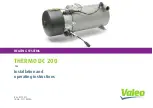
Page 5
Before energising the equipment, the following should be checked:
Voltage rating and polarity;
Protective fuse rating;
Integrity of earth connection
Equipment operating conditions
The equipment should be operated within the specified electrical and
environmental limits.
Insulation and dielectric strength testing
Insulation testing may leave capacitors charged up to a hazardous voltage.
At the end of each part of the test, the voltage should be gradually reduced to
zero, to discharge capacitors, before the test leads are disconnected.
Disposal
It is recommended that incineration and disposal to water courses is avoided.
The product should be disposed of in a safe manner.
Technical Specifications
Protective fuse rating
The recommended maximum rating of the external protective fuse for this
equipment is 2A, Red Spot type or equivalent.
Insulation class:
IEC 61010-1:
1990/A2:
1995
This equipment requires a
Class I
protective (safety) earth
EN 61010-1:
1993/A2:
1995
connection to ensure user
Class I
safety.
Installation
IEC 61010-1:
1990/A2:
1995
Distribution level, fixed
Category
Category III
installation. Equipment in
(Overvoltage):
EN 61010-1:
1993/A2:
1995
this category is qualification
Category III
tested at 5kV peak,
1.2 50
µ
s, 500
Ω
, 0.5J,
between all supply circuits
and earth and also
between independent
circuits.
Environment:
IEC 61010-1:
1990/A2:
1995
Compliance is
Pollution degree 2
demonstrated by reference
EN 61010-1:
1993/A2:
1995
to generic safety standards.
Pollution degree 2
Product safety:
73/23/EEC
Compliance with the
European Commission
Low Voltage Directive.
EN 61010-1:
1993/A2:
1995
Compliance is
EN 60950:
1992/A11: 1997
demonstrated by reference
to generic safety standards.
Summary of Contents for BA300
Page 2: ......






























